Conversations With Creatives: Art In The Garden
May 11, 2022As artists, we respond in all sorts of ways to gardens. In our most recent podcast we spoke with Marney-Rose Edge, Ken Clarke, Paula Berrantes and Anais Lera. Depicting the blooms plein air or integrating organic sculptures into the landscape, travelling back to the overgrown patios of childhood or imagining intricate ecosystems – each of them employs a unique approach to ‘Art In The Garden’.

Conversation with Nature: Art In The Garden
From a homegrown oasis to the public park, gardens provide the lifeblood to private lives and local communities. In this episode, learn how artists Marney-Rose Edge, Ken Clarke, Paula Barrantes, and Anaïs Lera each employ a unique approach to art in the garden.

Conversations With Nature Gallery: Art In The Garden
Step out into the garden with your art and story. The micro ecosystem of a garden is a representation for the greater world.
Our spring gallery consists of 3 themes. Take part in any or all three themes for a chance to WIN a $50 Opus Gift Card and be featured in an Opus Article and on Social Media.

Marney-Rose Edge
Marney-Rose Edge is a Vancouver-based artist with a passion for flowers. A keen gardener herself, Marney-Rose’s work is anchored in the fragility of nature. She is also a popular and well-respected teacher and juror, sharing her extensive knowledge with students and peers across Canada.
I visit a lot of the gardens around my neighbourhood and my community when I’m out driving. I will pull up and take photos of other people’s gardens. It’s just something that strikes to my core.
Nature is the best at putting colour combinations together. I work in a complementary colour scheme most of the time and nature is just a natural painter.
I started painting in my forties and just found such a passion for it. I was obsessed. We tend to try out all different mediums and genres and our best work comes out of what really suits us. Flowers were my first thing. That beauty and light – there’s just so much translucency, which I love, and it’s that feeling I get when I’m painting flowers that just goes hand in hand.
To be able to walk through, take that deep breath and inhale the perfume from a natural flower is just intoxicating. All the stress of the day just falls away when you breathe in that fragrance, so it plays an important role for me.

To have that immediacy of being out in the open, in the garden, in amongst those wonderful flowers and to be able to capture those colours – that’s how I’m treating plein air. Because it’s actually quite challenging. How do you narrow it down? What do you do? It’s overwhelming!
Focus in on what really grabs you, the different colours. The more information the better. You can zoom in, pull back, get some leaves. You may change your angle – one foot will change the perspective of what you’re looking at.
Whenever I’m driving anywhere I’m always looking at the gardens to see if there’s something. It’s about always keeping an eye out for what’s intriguing and what you can say.
Marney-Rose’s Top Art Supplies
- Arches 140lb cold press watercolour paper. This paper is perfect for building layers of paint and it is tough enough that it can withstand scrubbing.
- Pebeo Drawing Gum. Love this for a few reasons. It has a low odour, even with age. It is coloured so I can see where I have masked it, and it can withstand a hairdryer.
- Cobalt blue watercolour paint by Winsor and Newton. I use it to push petals back and to add depth to centres of flowers
- Princeton angle watercolour brushes for OILS. Yes, I use watercolour brushes to paint in oils. They are soft and great for blending.
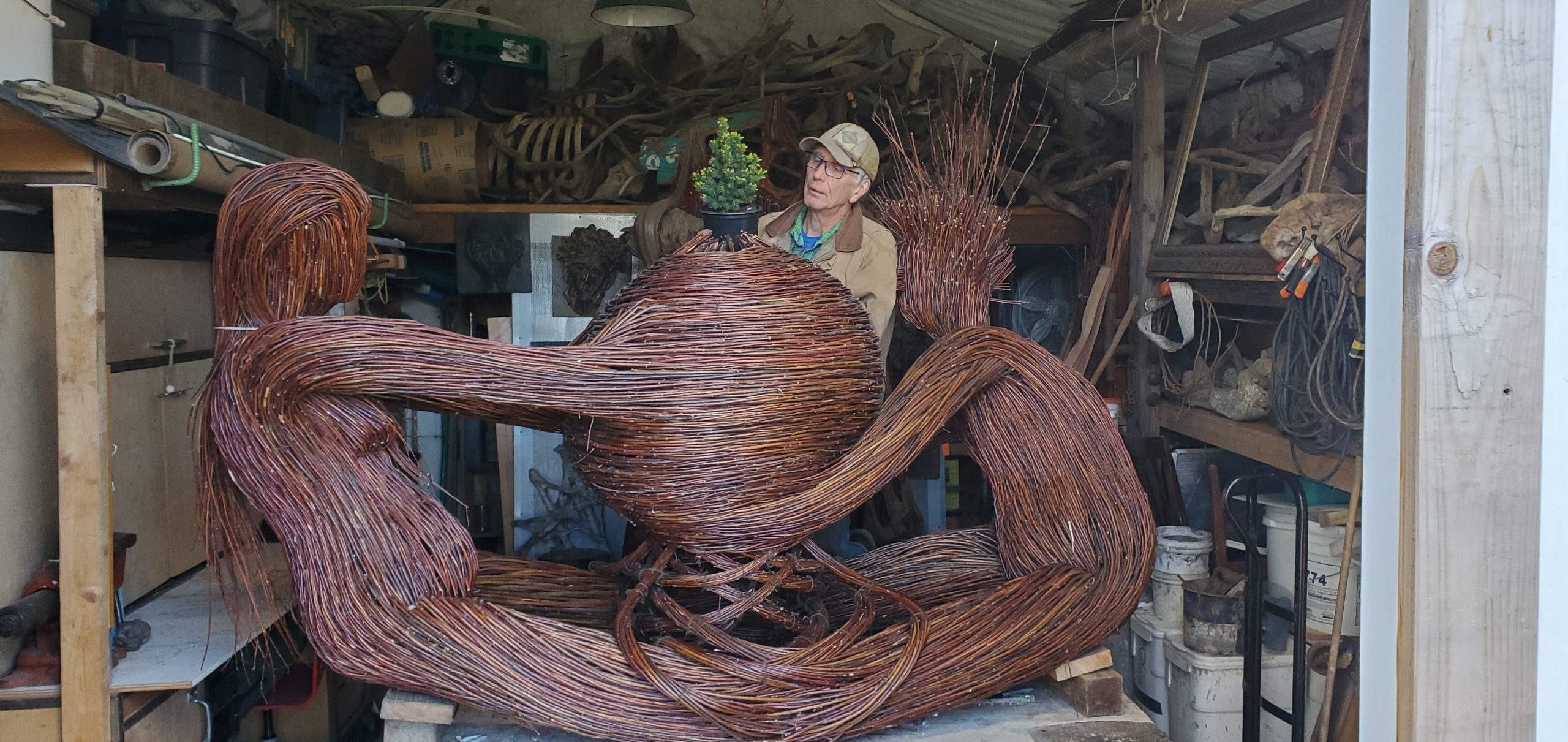
Ken Clarke
Known for his figurative work, grotesque faces, water and architectural features, Ken Clarke is a sculptor whose large scale, organic creations take pride of place in many private and public gardens around BC, including VanDusen. Always amazed by what nature has created through erosion and time, Ken explores natural forms and conveys the essence of that process.
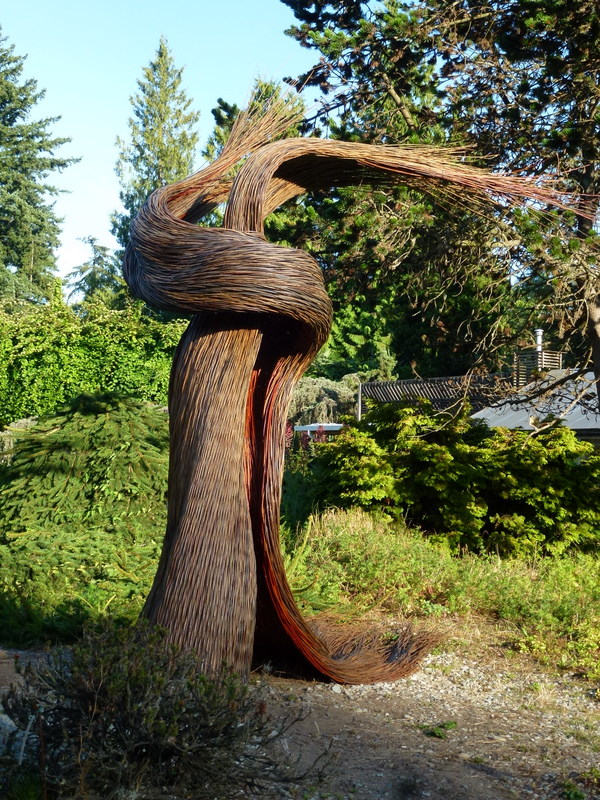
I was using willow but I thought I’d move on to some other materials. But willow was quite nice to work with – just working from nature, learning how to harvest and understanding where it comes from.
The last piece I’m doing right now is two figures sewing themselves together and weaving the earth. Eventually I want to have it outside with a plant growing out of the top of it.
I’ve started to make water features and waterfalls. Nature is just incredible with what it does over time. This last one is inspired by a canyon I saw in Fernie, on Coal River. I think it would be nice to see it in a kids’ hospital or old folks’ home, ‘cause if they can’t go there they can at least experience it on a smaller scale.
Right now my partner is planting around the studio space. It’s really nice to incorporate the plants in and around the pieces that I’m making.
When I go into nature it makes me laugh because I see what it does – its time, the way the roots grow around rocks – the shapes really inspire me.
I’ve reached a point where I feel really uncomfortable taking anything out of nature and I won’t take anything out anymore. I’m going to work with what I have and that’s it. I’ve used enough! I really like to see things left in nature and let it do its thing.
A garden just makes you feel good. It’s kind of nice when you create something that helps or makes even one person feel better. It just amazes me what nature can do for us and that’s inspiring.
Ken’s Top Art Supplies

Paula Barrantes
Paula Barrantes is a watercolourist and muralist specialising in botanical art, which allows her to feed a curiosity for the natural world and share her love for it with others. Whether depicting cuttings from her garden or interpreting the overgrown patios of her native Costa Rica, Paula’s art is about the joy of being surrounded by nature.
My passion is painting nature, specifically botanical art. In Latin America, our gardens aren’t intensely manicured – they’re dense and chaotic with lots of colour and texture and often saturated with upcycled cans and pots, holding the most beautiful orchids, vermiliads, begonias – anything with flowers!
We call our home gardens ‘patios’. They have a mixture of bare concrete, grass and soil and are usually in front of the house. This makes tending the plants easy but it’s also a way for neighbours to connect with each other. I grew up seeing my gramma interact with people this way and realised all these things that were so normal for me as a child have many layers of culture. It’s really inspirational and I knew I had to use it as my subject.
I live in the city, in downtown, and during lockdown I started gardening from food scraps in my apartment. To see through your plants is a reminder of the passage of time and I do portraits of them too.
Sketching from life is the best. I enjoy it most because I get to observe every detail, every vein, every fold of the plant, the colours – everything changes.
I have a one year-old daughter and walks are our everyday thing. I take her to public gardens, which are the ones that inspire my paintings now. I probably get five minutes when she’s calm but I get to sketch. Sharing this moment with her is very peaceful. I love watercolours for that reason. You can go fast and just bring a small kit with you.
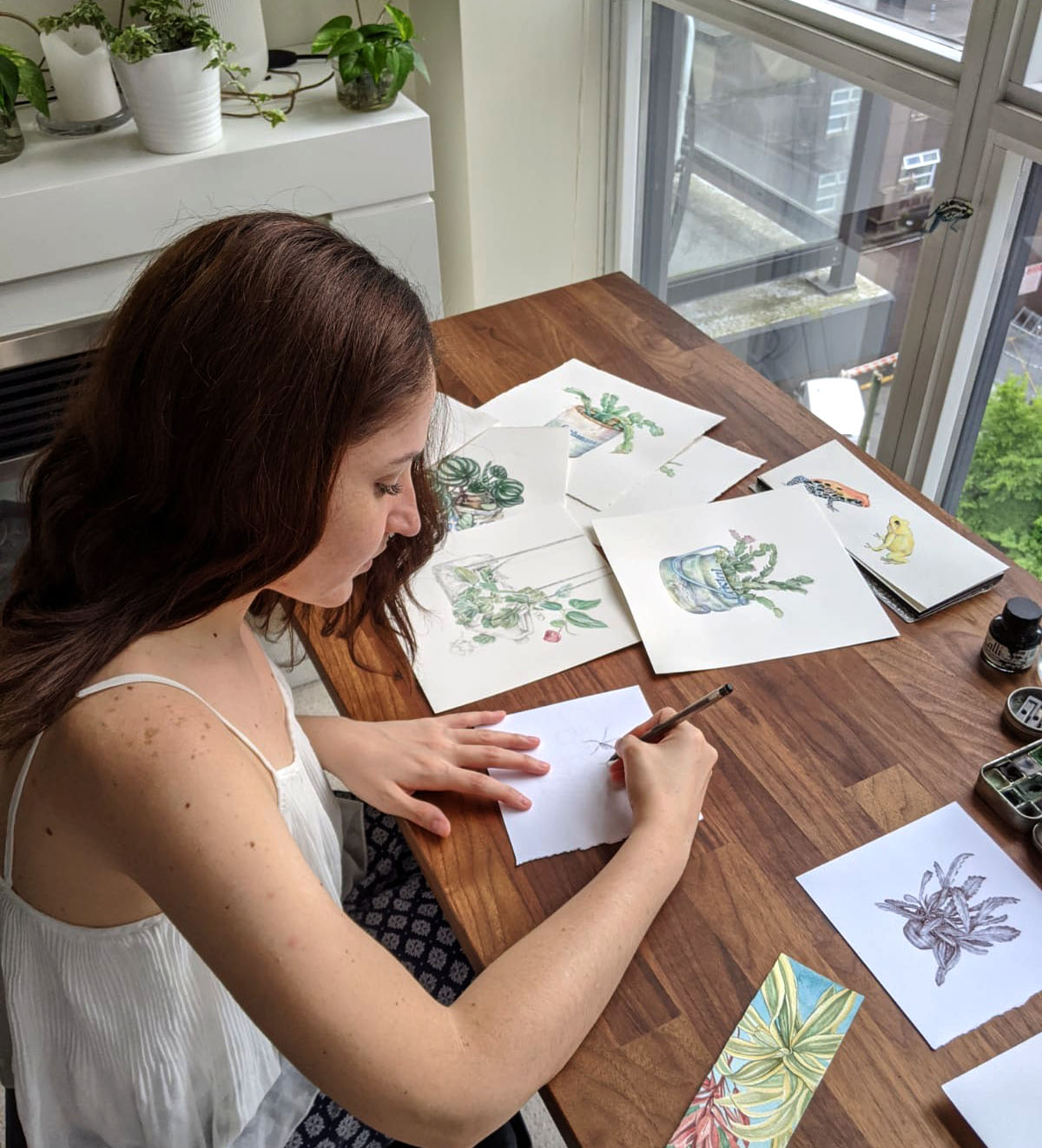
That connection with nature and sense of calmness is almost like meditation to me. It’s like a feeling of an oasis in the middle of the city, when you find that respire and tranquillity. All plants are beautiful, in every way. It doesn’t matter if there’s lots of colour or just variations of green.
Paula’s Top Art Supplies
- Daniel Smith PRIMATEK Watercolours 5ml Tubes Set 6. My all time favourite colour in this set is Jade
- Arches Cold Press Watercolour Pad. Any size. Also the best birthday gift 😉
- Da Vinci watercolour round brushes #2 and #0
- Faber-Castell Kneaded Eraser with Case, Grey
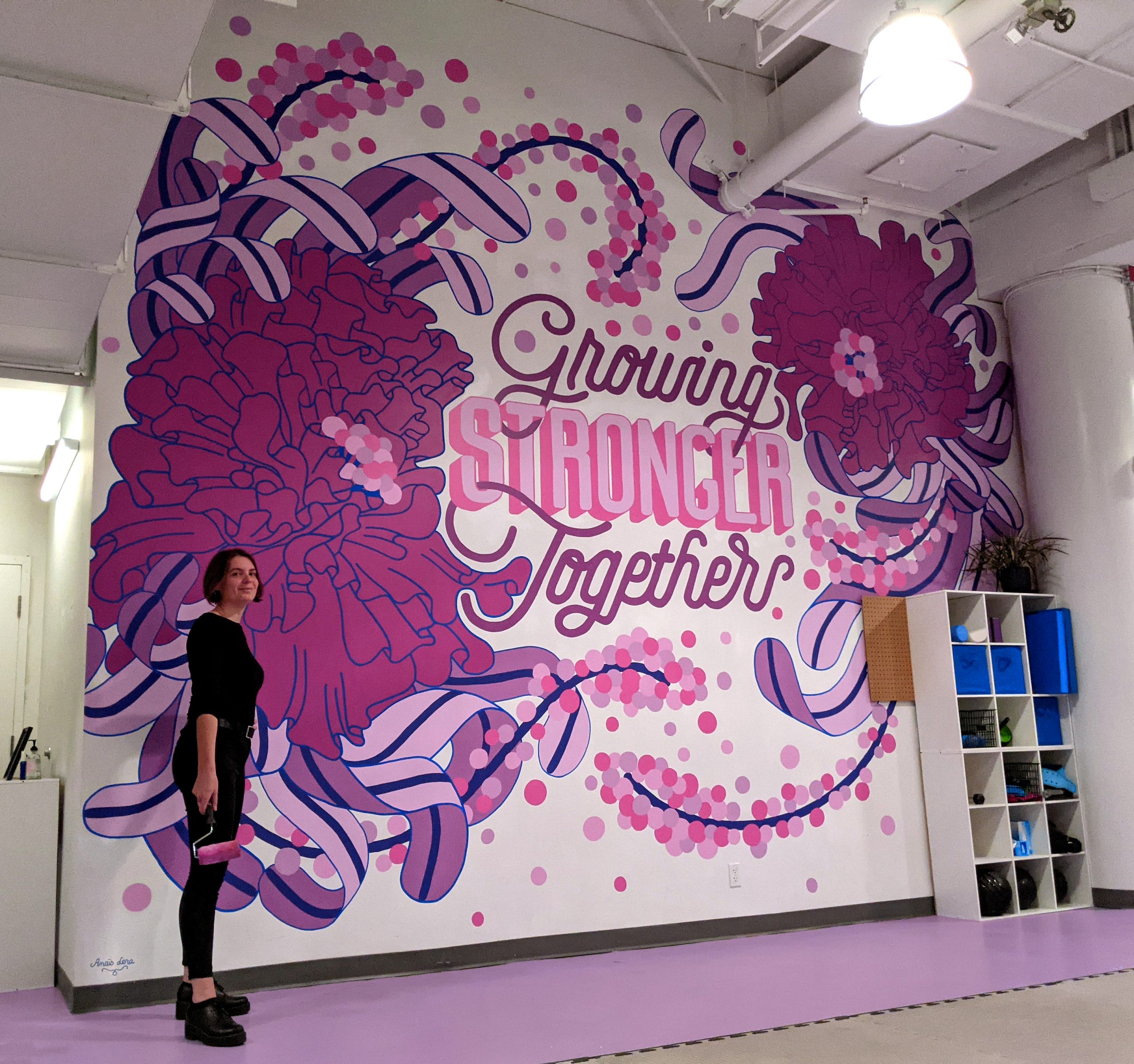
Anaïs Lera
Anaïs Lera is a French mural artist and painter currently living and working in Vancouver. Inspired by the beauty of nature, her immersive work weaves together luxuriant and colourful composition with meticulous design. Akin to a gardener, she creates intricate, imagined ecosystems, exploding with vibrant flora and fauna.
As an artist, when you’re in front of a garden it’s impossible to put everything into one piece. A big part of the process is choosing what you’re going to represent. If you put too much, you lose the information, if you don’t put enough it becomes boring, so you have to find the right balance of making the shapes and colours fit together. In the garden you have it all together and it’s just perfect.
My inspiration is this idea that humans are part of nature and nature is bigger than humans. The Pacific is stunning for blossoms and flowers, but I was really influenced by two years living in Australia – those crazy, very flashy colours of flowers you don’t really see in Europe.
When I’m in nature, I’m in nature. I don’t really like to be behind my phone, taking pictures off a screen. I don’t try to copy nature, I just try to capture the feeling I have when I look at it. I play a lot with pattern, repetition and movement in my drawing. I think the fact I focus more on this than trying to reproduce exactly what I’m seeing makes the work more emotive.
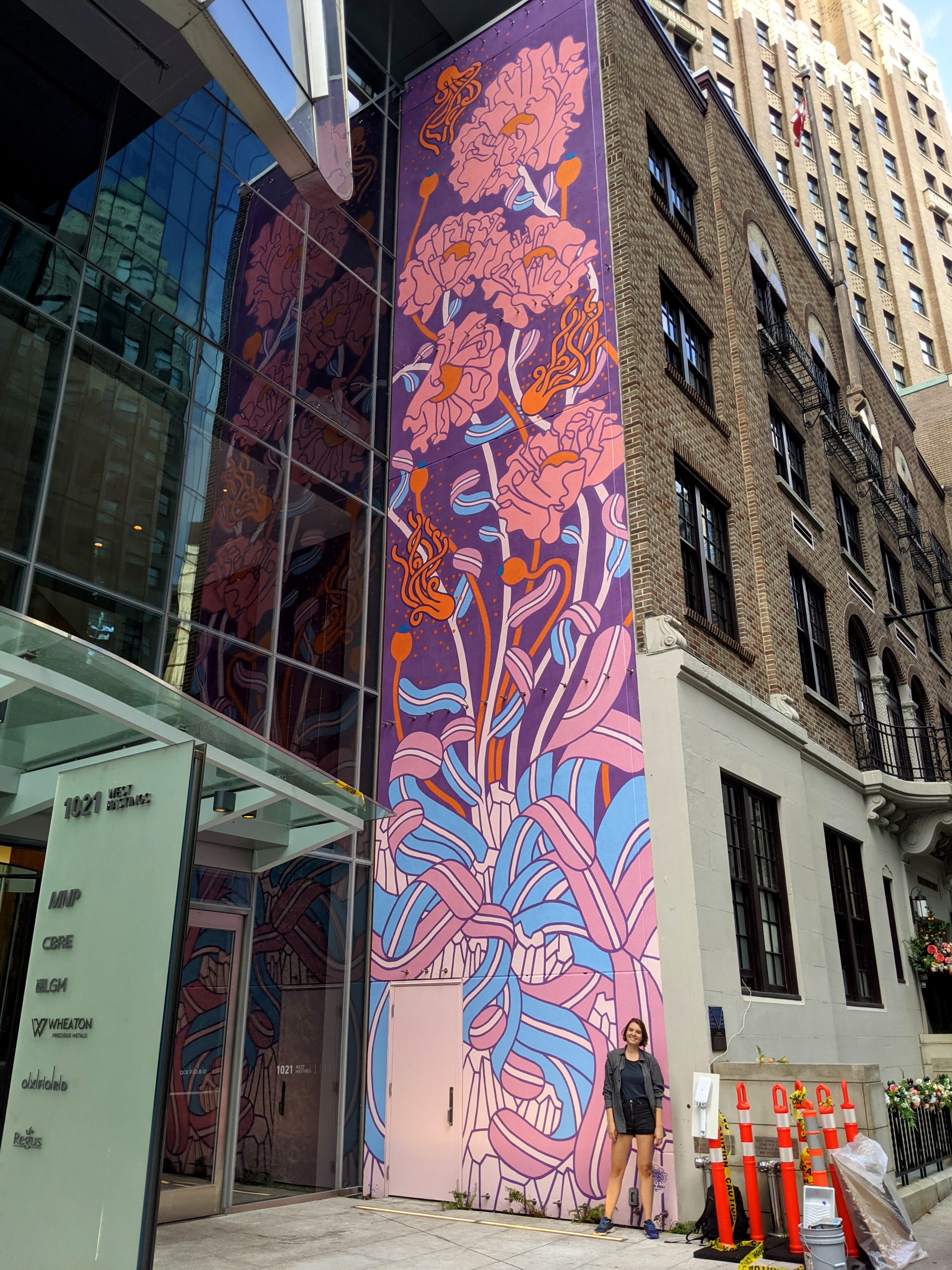
When you see a piece of art, I like the idea that people can dive in and be surrounded mentally by all the elements. That’s definitely what a garden is as well. Nature is already perfect the way it is, so it’s much more fun or interesting to create something new.
Anaïs’s Top Art Supplies
- Opus Legato acrylic brushes round (12 and 8) series 550 for indoor mural painting.
- Princeton brushes liner (10×0, 1 and 2) series 3750 for gouache painting.
- Princeton brushes round 2 series 3750 for gouache painting.
- Staedler fine liner black 0.3 (the best fine liner!)
